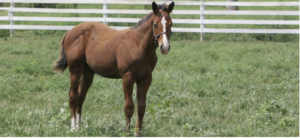 Managing Feed for Weanling and Yearling Horses: Young horses need good-quality feeds to meet their nutrient requirements for growth. In addition, free-choice exercise in large paddocks. Weanlings and yearlings have high requirements for energy, protein, amino acids and minerals in order to grow optimally. If you are using a commercial mixed feed, make sure it is formulated for the growing horse.
Managing Feed for Weanling and Yearling Horses: Young horses need good-quality feeds to meet their nutrient requirements for growth. In addition, free-choice exercise in large paddocks. Weanlings and yearlings have high requirements for energy, protein, amino acids and minerals in order to grow optimally. If you are using a commercial mixed feed, make sure it is formulated for the growing horse.
Energy
Oats are often the cheapest source of energy for young horses. They are best fed crushed to weanlings because their teeth are not fully developed and they will have trouble breaking open whole grains. Steam flaked maize (corn), barley and lupins are other grains that are good sources of energy for the growing horse. Lupins also have high protein levels. Adding fat is a safe way to rapidly condition your young horse. You can use oil, sunflower seeds, stabilised rice bran or a higher fat prepared feed. A general rule of thumb is to provide 1 kg of fortified grain per 100 kg of body weight, up to a maximum of 3 kg/day per weanling. Good doers such as warmbloods, quarter horses and ponies may get fat on these concentrate feed intakes! They do better on a low intake feed balancer pellet or a more concentrated breeding feed.
Protein
Weanlings need approximately 15% crude protein and yearlings need 13% crude protein in the diet along with adequate intakes of essential amino acids such as lysine to maintain optimum growth. Young green grass or clover pasture contains 15–20% crude protein. However this amount falls rapidly as the plants begin flowering and start to seed. Dry summer or winter pasture often contains very little protein, so yearlings will need supplementation. Young horses need high-quality protein that contains all the essential amino acids, especially lysine. Animal-derived proteins such as milk powder are of very high quality but are expensive, and soybean meal is the best-quality vegetable protein. Canola meal is also a good quality protein source. Legumes such as lucerne and clover also have a high level of good quality protein. Linseed meal is relatively low in lysine and is not a good source of protein for growing horses, although its high oil content will produce a bloom on the coat.
Vitamins and Minerals
Calcium and phosphorus are the most important minerals for growing horses. Grains are low in calcium, whereas lucerne, clover hays and high-quality pasture contain more calcium. However winter and spring pastures may unexpectedly contain ration inversions of calcium to phosphorus. Bran contains a lot of phosphorus and should not be fed in significant quantities to growing horses. Urinalysis can be used to assess the calcium status of young horses. The calcium to phosphorus balance of the ration can be analysed by an equine nutritionist.
Young horses running in a paddock can lose 30 g of salt per day in their sweat and urine, especially during hot weather, so provide a salt block or supply a salt supplement.
Trace minerals such as copper, zinc, manganese, and selenium are important components in the diet for most growing horses. They need to be supplied in the right quantities and ratios in commercial feeds formulated for young horses.
Roughage
To meet the commercial growth requirements of young horses, you may have to feed them less roughage than desired for optimal digestive function. Therefore, you must use good-quality chaff or hay to maximize the utilization of the fibrous feed in meeting the energy requirements. Also decrease the amount of starch the weanling has to be fed. High-quality, early-cut hay will also minimize the pot-belly appearance caused by fibre and water in the gut, a situation often associated with mature hay with high lignin content. Lucerne or clover hay will also supply higher intakes of protein and calcium as well as fibre. They are often preferred for growing horses. As the horse gets older it eats more, so you can switch from a legume hay to a grass or oaten based hay. This is true particularly during spring when they have access to green grass.
Choice of Feed
If you have great quality pasture or are feeding breeds with a good metabolism, such as warmbloods, quarter horses, draught breeds or ponies, a feed balancer pellet or a concentrate is often the best approach.
Remember to monitor growth, legs and body condition carefully. Adjust feed intake or choice of feed in order to maintain optimum growth for each individual weanling and yearling.
Would you like more information about Managing Feed for Weanling and Yearling Horses? Contact us at J & J Farms by clicking here!
Article brought to you by KER.
